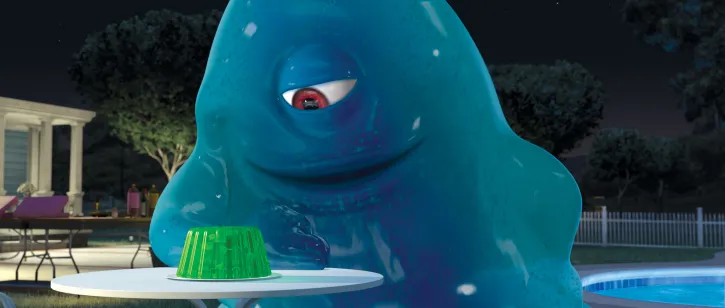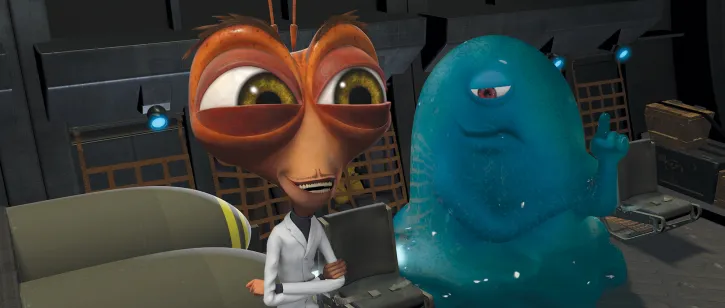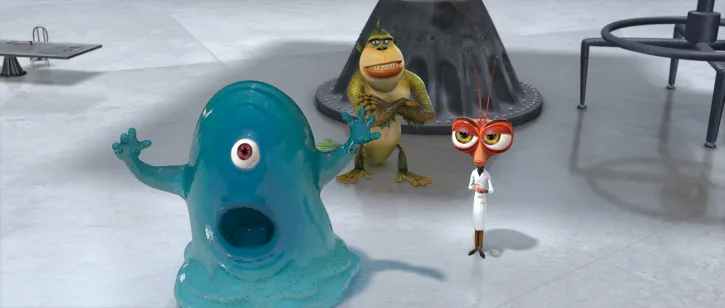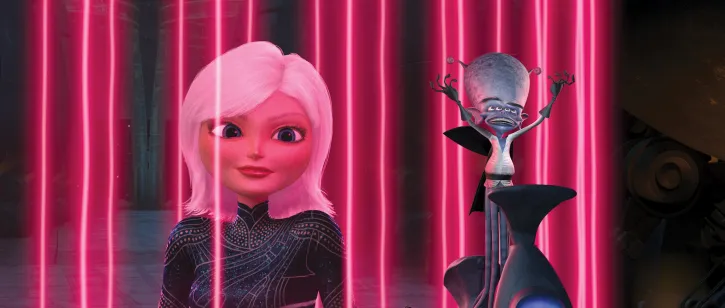Monsters vs. Aliens is a 2009 animated film that is the embodiment of Karl Marx's work. In this article, I will explain how the film is a perfect representation of Marx's ideas.
The Base Plot
The movie begins when Susan, voiced by Reese Witherspoon, is hit by a strange green meteorite on her wedding day (side note: when it is in space, it's called an asteroid, but when it hits the ground, it's called a meteorite). The meteorite is revealed to contain a substance called quantonium, which causes Susan to permanently grow to a height of 49 feet, 11 inches (15.21 meters). She is immediately captured by the military, branded a “monster”, and brought to a secret government facility, where she meets three other monsters.
The main plot of Monsters vs. Aliens revolves around an alien invasion led by the evil Gallaxhar, who seeks to conquer Earth and enslave humanity. Gallaxhar seeks to exploit and oppress the Earth for his own gain. He is a ruthless and power-hungry dictator who will stop at nothing to achieve his goals, even if it means destroying the planet and all its inhabitants.
After a battle with Gallaxhar's robot probe, the President of the United States decides to send the monsters to confront the alien invader. The monsters respond to the call, despite having been imprisoned by the government for years, and manage to defeat Gallaxhar, destroy his mothership, take back control of the quantonium, and save the world. Along the way, Susan learns to accept and embrace her new identity as a “monster” and finds happiness and fulfillment in her new life.
The Monsters
B.O.B.

B.O.B. is a blue gelatinous mass with no brain, voiced by Seth Rogen. He is described as having formed as a result of a ranch dressing experiment gone wrong (his name means Benzoate Ostylezene Bicarbonate). B.O.B. is very friendly and likeable, but he also has no brain, and is therefore unable to think for himself.
B.O.B. is an excellent representation of the working class, who are often treated as sheep with no brains and are expected to follow orders without question. Bobby is also a metaphor for the working class's supposed lack of individuality, as he is literally a mass of identical cells with no distinguishing features.
However, despite his small intelligence, B.O.B. can be very resourceful and creative when he needs to be. He always remains friendly and optimistic, even in the face of danger.
Turns out, you don't need [a brain]. Totally overrated! As a matter of fact, I don't even...
[starts gasping for air]
I forgot how to breathe! Don't know how to breathe! Help me, Doctor Cockroach! Help! Help!
Dr. Cockroach

Dr. Cockroach, Ph.D. (voiced by Hugh Laurie), is a mad scientist who accidentally turned himself into a giant cockroach man while working in his lab. Cockroach was caught by the military in 1952 and has been held in captivity ever since. He is very intelligent and resourceful, being able to construct goofy gadgets out of everyday items.
Dr. Cockroach is a metaphor for the intellectuals among the working class, who are often seen as dangerous as they possess the knowledge and skills to challenge the status quo. Dr. Cockroach is also a metaphor for the working class's ability to adapt and survive in difficult circumstances (like cockroaches, though it should be noted that the idea of cockroaches being able to survive a nuclear apocalypse is a myth).
The Missing Link

The Missing Link (voiced by Will Arnett) is a 20,000-year-old fish-ape hybrid that was thawed out of a block of ice by scientists. He is out of shape but likes to pretend to be strong and tough, such as in the scene where he pretends to have lifted weights a thousand times while Susan passes by, despite only having lifted them a couple of times.
I don't really have a good metaphor for The Missing Link, but I think he's a good representation of people's desire to be strong and tough, even when they are not.
Susan Murphy

The main character of Monsters vs. Aliens, Susan Murphy, is a representation of the freedom of the individual, as well as a feminist icon. At the beginning of the movie, Susan is a normal woman on her wedding day with Derek Dietl, a local weatherman. However, after being hit by the quantonium meteorite, Susan expands to gigantic proportions and is captured by the military.
Feminism
Susan is branded a “monster” by the military and is held in captivity, despite the fact that she has done nothing wrong, on the basis of her appearance. This pretty obviously mirrors the treatment of women who don't follow strict beauty standards in our society. One might also argue that Susan's skin-tight stretching suit imposed by the military and Gallaxhar is a statement on the certain kinds of clothing that gender norms force on us, though that might be a bit of a stretch. (Sorry for the pun.)
Throughout the film, Susan struggles with her new identity as a monster and the loss of her old life. She is forced to confront the fact that she is no longer the person she once was, and must learn to accept and embrace her new self. She becomes proud of herself and her new abilities, and ultimately saves the day by defeating the alien invader Gallaxhar, thus accepting herself as a “monster” and embracing her new identity. This is a powerful message of self-acceptance and empowerment.
Her story also has a happy ending, as she is able to get accepted by the public and the government as a hero for saving the world. (This might be trying to show us that under a capitalist system, change from societal norms will be reprimanded unless it proves to be exploitable.)
Individualism
This character is clearly an interpretation of Marx's idea of the individual, as Susan is the only one of the monsters that is not a product of the government's experiments. She is a free agent, able to make her own choices and decisions, and is not bound by the constraints of the government or society. Susan is able to think for herself and act independently, and she is therefore able to challenge the status quo and bring about change (acceptance of the monsters by the public).
Themes of the Movie
Class Struggle
The main theme of Monsters vs. Aliens is the struggle between the working class and the ruling class (well, between Monsters and Aliens, but the metaphor is there). The monsters, representing the proletariat, are oppressed and exploited by the government and the military, who seek to control and manipulate them for their own gain. The monsters are treated as second-class citizens, denied their freedom and their rights, and forced to live in captivity.
Gallaxhar, representing the bourgeoisie, desires the quantonium (a metaphor for the means of production as described by Marx) in order to enslave humanity: the quantonium allows him to create an army of clones that he attempts to deploy as an army to conquer Earth.
Ultimately, the monsters are able to overcome their oppressors and defeat Gallaxhar, thus liberating themselves from their chains and achieving freedom and equality. The monsters are able to unite and work together to achieve their goals, demonstrating the power of collective action and solidarity. However, the movie ends with the monsters working for the government (voluntarily this time), which is a statement on how the working class can be exploited even when they are free through the use of propaganda and manipulation.
Alien Hegemony
The alien invasion led by Gallaxhar is a metaphor for imperialism and colonialism. Mark criticizes the exploitation and oppression of indigenous peoples by foreign powers, and the destruction of their cultures and way of life: ironically, this time the U.S. is the one being oppressed instead of plundering other countries. This is the struggle against hegemonic control.
Labor and Exploitation
Despite, or because of, their unique abilities, the monsters are kept hidden in a secret government zone (Area Fifty-Something) and are not allowed to leave. They are forced to work for the government and are not paid for their labor, then deployed against Gallaxhar when all else fails. This parallels the exploitation of labor by capitalists and the alienation of the worker from the product of their labor.
The monsters become living weapons for the U.S. government: they are forced to risk their lives and fight for a cause that is not their own, and they are not given any say in the matter. This is akin to slaves being forced to fight in wars for their masters, or workers being forced to work in dangerous conditions for low wages in the real world.
Collective Action
At the end of the movie, the monsters, and the Government come together as a team to fight and defeat the aliens. Just like Marx emphasized the importance of collective action and solidarity among the working class, the monsters are able to achieve their goals by working together and supporting tjemselves. This is a great message of unity and cooperation, and demonstrates the power of the people when they come together to fight for a common cause.
The movie does not end in a real revolution, but in a compromise: the monsters are allowed to live freely in the world, but they are still working for the government. However, the common enemy is defeated, and the monsters are accepted by the public, which is a step in the right direction.
Conclusion
Monsters vs. Aliens is a brilliantly animated film that is a perfect representation of Karl Marx's ideas. The movie explores themes of class struggle, alien hegemony, labor and exploitation, and collective action, and demonstrates the power of the working class to overcome their oppressors and achieve freedom and equality. The monsters are able to unite and work together to defeat Gallaxhar and liberate themselves from their chains, showing that the people have the power to bring about change when they come together and fight for a common cause.
Of course, I am probably thinking way too deeply into this, and the movie was probably just meant to be a goofy movie for kids, but it's funnier to think of it this way.
Next up, I will explain how Biggie Cheese is actually a misunderstood anarchist icon. (Not really, but it could be funny)
Jesse W
